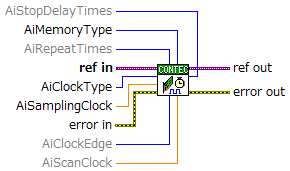

Select for continuous analog input

AiClockType |
[-1] Can be set |
Initial value: 0 (Internal clock) |
Specify the clock type (Internal clock/External clock)
0:
Internal clock
1: External clock
2: Synchronous Control Signal 1
3: Synchronous Control Signal 2
4: Synchronous Control Signal 3
AiSamplingClock |
[-1] Can be set |
Initial value: 1000 (uSec) |
Specify the speed of internal clock in uSec
*The range of configurable
clocks varies depending on the device
Please refer to [Device-specific
Setting List]
AiRepeatTimes |
[-1] Can be set |
Initial value: -1 (Not change) |
Specify the number of repeat times
Repeat action is the action from the sampling start to stop, which is performed for multiple times
0
: Repeat action is repeated infinitely
1 : Not perform repeat action
(Stop for sampling 1 time)
2 or more: Repeat action is performed
in the specified times
*In the initial state and if terminal is not connected, which is same as specify this terminal to 1. Not perform repeat action
*The USB devices except
for AIO-163202FX-USB do not support repeat action
Specify -1 to cancel this terminal, or specify 1
*Whether repeat action can
be performed and the upper limit of repeat times depend on devices
Please refer to [Device-specific
Setting List]
AiClockEdge |
[-1] Can be set |
Initial value: -1 (Not change) |
Specify the edge of external clock (Rising/Falling)
0:
Falling edge
1: Rising edge
*In the initial state and if terminal is not connected, which is same as specify this terminal to 0. Falling Edge is set
*The configurable external
clock edge varies depending on the device
Please refer to [Device-specific
Setting List]
AiMemoryType |
[-1] Can be set |
Initial value: 0 (FIFO) |
Specify the memory type (FIFO memory/RING memory)
0:
FIFO
1: RING
Memory
for data storage of analog input/output devices can be used in
two formats, they are FIFO and RING. Please refer to the table below for features of each format and proper usage.
|
AiScanClock |
[-1] Can be set |
Initial value: -1 (Not change) |
Specify the scan clock (delay
time between 2 channels) in uSec
When analog input by multiple channels, a time difference set in this terminal
will be produced by acquiring the analog data for each channel
*In the initial state and if terminal is not connected, the minimum value (the fastest speed) of device is set
*Whether the scan clock
can be set or not, and the range of available value depend on device
Pleasd refer to [Device-specific
Setting List]
AiStopDelayTimes |
[-1] Can be set |
Initial value: -1 (Not change) |
Specify the number of delay
samplings
Delay samplings is the sampling which is performed after the sampling stop
conditions are satisfied
If the [Setting for Stop] isn't [Software], this terminal can be used
*In the initial state and if terminal is not connected, which is same as specify this terminal to 0. Not perform delay sampling